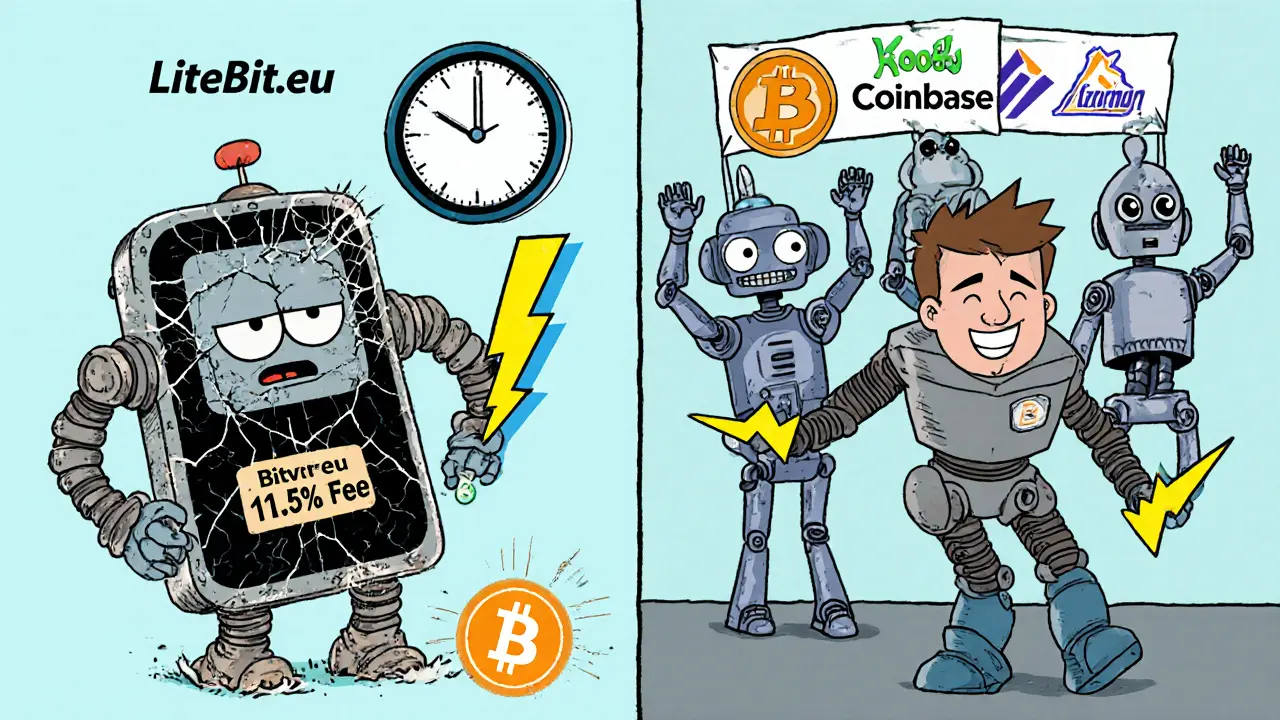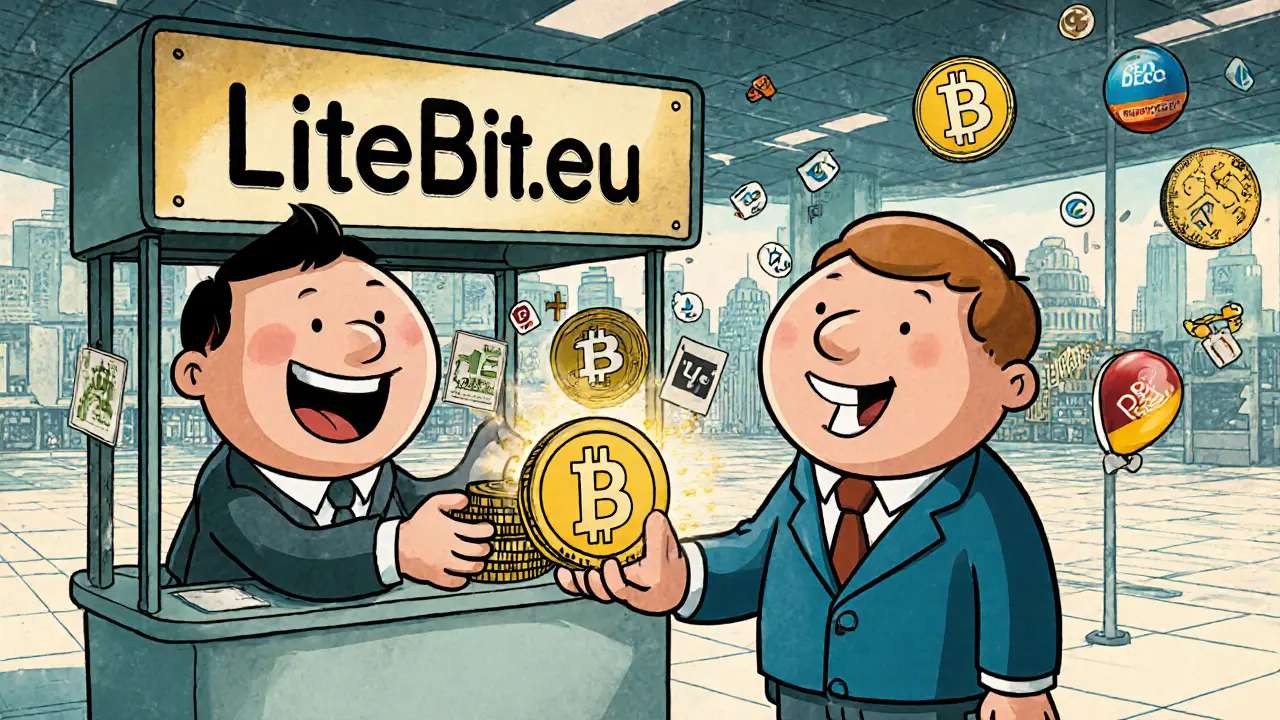Crypto Purchase Fee Calculator
Compare Your Crypto Purchase Costs
See how much you'd save by choosing alternatives to LiteBit.eu. LiteBit charged a 1.55% markup on all purchases. Most exchanges charge significantly less.
LiteBit charged a fixed 1.55% markup on all purchases. This calculator shows you how much you'd save by using one of the alternatives. Remember: the longer you hold your crypto, the more these fees add up!
LiteBit.eu was once one of the most popular ways for Europeans to buy Bitcoin and other cryptocurrencies with euros. If you used it in 2018, you probably remember how simple it was: log in, pick your coin, pay with iDeal or credit card, and get your crypto in minutes. No order books. No trading charts. No complex fees. Just buy and go. But that simplicity came at a cost - and today, LiteBit.eu doesn’t exist anymore.
How LiteBit.eu Actually Worked (It Wasn’t a Real Exchange)
Most people thought LiteBit was a crypto exchange like Binance or Kraken. It wasn’t. LiteBit was a broker. Think of it like a currency exchange booth at the airport. You walked in with euros, they gave you dollars at a fixed rate with a small markup. LiteBit did the same with Bitcoin, Ethereum, and over 50 other coins.
Instead of matching buyers and sellers like a true exchange, LiteBit bought crypto on the open market and sold it to you at a 1.55% markup. That’s higher than most exchanges charge, but back then, it was the price of convenience. If you didn’t know how to use an exchange, didn’t want to manage a wallet, or just wanted to buy Bitcoin without learning technical terms, LiteBit made it easy.
They even invented something called LiteBit Credits (LBC). You’d buy credits with euros, then use those credits to buy crypto later. Why? Because bank transfers in Europe could take 2-3 days. If Bitcoin jumped 5% while your money was in transit, you’d lose money. With LBC, you locked in the price when you bought credits. It was a smart fix for a real problem - and one most exchanges ignored.
Who Used LiteBit.eu - And Why
LiteBit didn’t target traders. It targeted beginners. People who wanted to buy their first Bitcoin to give to a friend. Parents buying Ethereum for their college-age kids. People in Germany, the Netherlands, and Belgium who trusted iDeal and Bancontact payments. By 2018, they had 800,000 registered users - mostly casual buyers, not day traders.
The platform was built for simplicity:
- One-click buy/sell
- Integrated wallet (no need to download MetaMask or Trust Wallet)
- 24/7 customer support in Dutch, German, and English
- Mobile app with crypto news updates - rare for a broker at the time
- Biometric login and 2FA for security
For someone who just wanted to buy crypto and forget about it, LiteBit was perfect. No need to understand order types, spreads, or liquidity. You didn’t need to worry about cold storage. LiteBit handled it all.
Why LiteBit.eu Failed
But simplicity isn’t enough if the market moves faster than you do.
By 2020, things started to change. New competitors popped up. Bitvavo launched with lower fees and real exchange features. Binance entered the EU market with a local version. Coinbase Pro offered better rates and deeper liquidity. These platforms didn’t just sell crypto - they let you trade it, set limit orders, track charts, and even earn interest.
LiteBit didn’t keep up. They didn’t add new features. They didn’t lower their fees. Their mobile app stayed the same. Their website looked dated. While others were adding staking, futures, and API access, LiteBit stuck with buy/sell only.
And then came the fees. A 1.55% markup sounds small - until you realize Binance charges 0.1% for trades. If you bought $1,000 worth of Bitcoin on LiteBit, you paid $15.50 extra. On Binance, you paid $1. That’s 10x cheaper. For someone buying $100 a month, it adds up to $186 a year. People started noticing.
Trustpilot ratings dropped to 3.3/5. BitCourier gave them 2.5/5. Users complained about:
- Slow account verification - sometimes took over a week
- Delayed deposits - especially for German users using Giropay
- Confusing follow-up calls from support after purchases
Some users said the first purchase was a nightmare. The second was fine. That inconsistency killed trust. People don’t mind paying a little more for reliability. But if the service feels broken the first time, they won’t come back.

What Happened to LiteBit.eu?
In early 2025, LiteBit.eu quietly shut down. No big announcement. No press conference. Just a short statement on their website: “We have ceased operations.”
No one knows exactly why. But the signs were clear. The business model was outdated. The fees were too high. The competition was too strong. And the users? They had better options.
What happened to your coins? The company claimed all customer funds were protected and returned. But no public audit or detailed plan was released. If you still had crypto on LiteBit, you had to act fast - or lose it. Most users had already moved their funds out by then.
Best Alternatives to LiteBit.eu in 2025
If you’re looking for something like LiteBit - simple, secure, and built for beginners - here are your best options today:
| Platform | Best For | Fees | Payment Methods | Supported Coins | Wallet Included |
|---|---|---|---|---|---|
| Bitvavo | EU beginners who want low fees | 0.25% trading fee | iDeal, SEPA, credit card | 150+ | Yes |
| Coinbase | US and EU users who want trust | 0.5%-1.49% (depends on payment) | Bank, card, Apple Pay | 200+ | Yes |
| Kraken | Users who want to grow into trading | 0.16%-0.26% (volume-based) | SEPA, card, wire | 200+ | Yes |
| Bybit | Users who want to trade later | 0.1% spot fee | SEPA, card, crypto | 300+ | Yes |
Bitvavo is the closest replacement. It’s Dutch, supports iDeal, has low fees, and lets you buy crypto with just a few clicks. It even has a simple buy/sell mode for beginners - just like LiteBit. But it also lets you trade like a pro if you ever want to.
Coinbase is the safest bet if you’re outside the Netherlands. It’s regulated, easy to use, and has the most brand trust. But it’s more expensive than Bitvavo.

Should You Use a Crypto Broker Like LiteBit?
Maybe - if you’re just starting out and only plan to buy crypto once or twice a year. If you’re going to hold for 5 years and never touch it, a broker is fine.
But if you plan to buy regularly, trade, or hold more than a few hundred euros worth of crypto - skip the broker. Use a real exchange. Fees add up fast. And you’ll want more control over your assets.
Also, never leave crypto on any exchange long-term - broker or not. Move it to a hardware wallet like Ledger or Trezor. LiteBit’s integrated wallet was convenient, but it wasn’t yours. If the company shuts down, you’re at their mercy.
What LiteBit’s Closure Teaches Us
LiteBit didn’t fail because it was bad. It failed because it stopped evolving.
It solved a real problem in 2014: “How do I buy Bitcoin without knowing anything?” But by 2023, that problem had been solved better by others. The market moved. Users got smarter. And LiteBit stayed still.
That’s the lesson for anyone using crypto today. Platforms rise fast. But if they don’t adapt, they vanish. The ones that last - like Binance, Coinbase, and Kraken - keep improving. They add features. They lower fees. They listen.
LiteBit was a good first step for many. But it shouldn’t be your last.
Is LiteBit.eu still operating in 2025?
No, LiteBit.eu shut down in early 2025. The company announced its closure with no fanfare, and the website now redirects to a message stating operations have ceased. All services, including trading and withdrawals, are no longer available.
What happened to users’ crypto on LiteBit?
LiteBit claimed all customer funds were returned before shutdown. However, no public audit or detailed process was published. Users were advised to withdraw their assets before the closure date. If you still had crypto on LiteBit after the shutdown, there is no known way to recover it.
Why did LiteBit charge such high fees?
LiteBit operated as a broker, not an exchange. Instead of matching buyers and sellers, they bought crypto on the open market and sold it to you at a fixed markup - around 1.55%. This model made it easy for beginners but became uncompetitive as exchanges like Binance and Bitvavo offered fees under 0.25%.
What was LiteBit Credits (LBC)?
LiteBit Credits (LBC) were a buffer system to protect users from price swings during bank transfers. You’d buy credits with euros first, then use them to buy crypto later. This locked in the price upfront, so if your bank transfer took 2 days and Bitcoin rose 5%, you still got the original rate. It was a smart workaround - but only one of its few innovations.
Is Bitvavo the best replacement for LiteBit?
Yes, for EU users, Bitvavo is the closest replacement. It offers the same simple buy/sell interface, supports iDeal and SEPA, has low fees (0.25%), and includes a built-in wallet. It also supports over 150 cryptocurrencies and has a clean mobile app. Unlike LiteBit, Bitvavo keeps improving and adding features.
Should I use a crypto broker or an exchange today?
Use a broker only if you’re buying crypto once or twice a year and want zero complexity. For regular buying, trading, or holding more than a few hundred euros, use a real exchange like Bitvavo, Kraken, or Coinbase. They’re cheaper, faster, and give you more control. Never leave crypto on any exchange long-term - move it to your own wallet.

Noriko Yashiro
November 12, 2025 AT 15:20LiteBit was my first crypto gateway and honestly? I loved it. No stress, no charts, just buy and forget. I bought my first BTC for my niece’s birthday and she still has it. Simple isn’t bad-it’s just rare now.
Michael Brooks
November 13, 2025 AT 06:54They didn’t fail because they were bad. They failed because they didn’t evolve. That’s the story of every company that thinks convenience is enough. The market doesn’t wait for nostalgia.
Rachel Everson
November 13, 2025 AT 09:23Bitvavo is literally LiteBit 2.0. Same vibe, same iDeal support, but they actually update their app. I switched in 2022 and haven’t looked back. Also, their customer service doesn’t call you after you buy. Huge win.
Diana Dodu
November 14, 2025 AT 10:59Of course it shut down-Europeans can’t handle real finance. They want their crypto handed to them like a lollipop. Meanwhile, Americans are stacking sats and building portfolios. This is why the US leads.